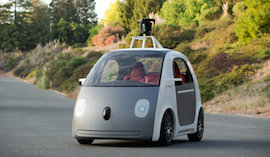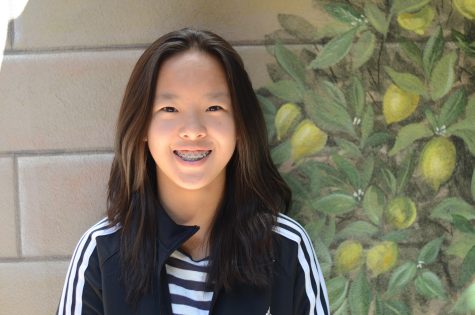Updated Google driverless cars hit the road

Google’s new driverless car cruises through the streets, using the sensor array mounted on the roof to steer. The car is equipped with manual controls to comply with California state law.
Google released its first fully functional self-driving car in December that included real headlights and temporary controls. Though these driverless cars haven’t been put on roads yet, they are anticipated to be released in the near future.
The cars, which the company has worked on for five years, were driven over 700,000 miles to ensure reliability. The recent prototype has manual that are necessary in order to abide by California state law.
The first autonomous car, Stanley, was created by Sebastian Thrun, a part-time professor at Stanford, and his team of fifteen engineers. The car went on to win the 2005 Defense Advanced Research Projects Agency (DARPA) grand challenge. Thrun is currently in charge of Google’s project to develop autonomous cars for the use of the general public.
After encountering an accident at the age of 18 that involved losing his best friend to a car accident, Thrun was inspired to create these self-driving cars to reduce car accidents and to help save lives.
Engineers at Google initially tested out the technology on Lexus, Toyota, and Audi car models. In 2012, Google released a video of a legally blind man, Steve Mahan, going for a ride in a modified. autonomous Toyota Prius.
“Where this would change my life is to give me the independence and the flexibility to go the places I both want to go and need to go when I need to do those things,” said Mahan in the video released by Google.
“I think Google’s self-driving cars are absolutely amazing because they are pretty much like limitless taxis. They’ll greatly reduce parking and traffic flows so they’ll just make everything faster and more convenient,” David Zhu (10) said. “It’ll really help handicapped people who can’t drive easily move from place to place.”
In May, the initial design for the car was unveiled. At the time, the car did not have a steering wheel, gas and brake pedals, headlights and other controls.
“I think it’s a pretty cool idea; I’ve actually seen a video of it before and I thought it was very futuristic,” Sonali Netke (12) said. “I think it will especially help people who are blind and can’t drive, or people whose disabilities affect their driving–they’ll be able to get around a lot easier without relying on their family members so it’ll definitely benefit them.”
Google plans to release the car for to the general public between 2017 and 2020.
This piece was originally published in the pages of the Winged Post on January 28, 2015.

Ashley Jiang (11) is the photo editor for Winged Post. This is her third year in the journalism program, and she was a reporter her freshman and sophomore...
Meena Gudapati (12) is the Editor-in-Chief of Harker Aquila. Her favorite part of journalism is making her humorous podcast "Get Skool'd" and writing interesting...


















![“[Building nerf blasters] became this outlet of creativity for me that hasn't been matched by anything else. The process [of] making a build complete to your desire is such a painstakingly difficult process, but I've had to learn from [the skills needed from] soldering to proper painting. There's so many different options for everything, if you think about it, it exists. The best part is [that] if it doesn't exist, you can build it yourself," Ishaan Parate said.](https://harkeraquila.com/wp-content/uploads/2022/08/DSC_8149-900x604.jpg)




![“When I came into high school, I was ready to be a follower. But DECA was a game changer for me. It helped me overcome my fear of public speaking, and it's played such a major role in who I've become today. To be able to successfully lead a chapter of 150 students, an officer team and be one of the upperclassmen I once really admired is something I'm [really] proud of,” Anvitha Tummala ('21) said.](https://harkeraquila.com/wp-content/uploads/2021/07/Screen-Shot-2021-07-25-at-9.50.05-AM-900x594.png)







![“I think getting up in the morning and having a sense of purpose [is exciting]. I think without a certain amount of drive, life is kind of obsolete and mundane, and I think having that every single day is what makes each day unique and kind of makes life exciting,” Neymika Jain (12) said.](https://harkeraquila.com/wp-content/uploads/2017/06/Screen-Shot-2017-06-03-at-4.54.16-PM.png)








![“My slogan is ‘slow feet, don’t eat, and I’m hungry.’ You need to run fast to get where you are–you aren't going to get those championships if you aren't fast,” Angel Cervantes (12) said. “I want to do well in school on my tests and in track and win championships for my team. I live by that, [and] I can do that anywhere: in the classroom or on the field.”](https://harkeraquila.com/wp-content/uploads/2018/06/DSC5146-900x601.jpg)
![“[Volleyball has] taught me how to fall correctly, and another thing it taught is that you don’t have to be the best at something to be good at it. If you just hit the ball in a smart way, then it still scores points and you’re good at it. You could be a background player and still make a much bigger impact on the team than you would think,” Anya Gert (’20) said.](https://harkeraquila.com/wp-content/uploads/2020/06/AnnaGert_JinTuan_HoHPhotoEdited-600x900.jpeg)

![“I'm not nearly there yet, but [my confidence has] definitely been getting better since I was pretty shy and timid coming into Harker my freshman year. I know that there's a lot of people that are really confident in what they do, and I really admire them. Everyone's so driven and that has really pushed me to kind of try to find my own place in high school and be more confident,” Alyssa Huang (’20) said.](https://harkeraquila.com/wp-content/uploads/2020/06/AlyssaHuang_EmilyChen_HoHPhoto-900x749.jpeg)


